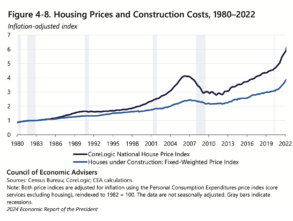
On Tuesday, the Trudeau administration announced a new, $6 billion housing infrastructure fund as part of a program to address a shortage of what the government terms housing for the “missing middle.” Conceptually, communities that agree to allow development of fourplexes, where previously they may only have allowed single-family homes, would be allowed access to the fund to address necessary infrastructure work such as sewer upgrades, water lines and street improvements. The program bears a clear resemblance to recommendations that recently appeared in a Biden administration report, so it begs the question of whether the US will launch a similar program tying serial funding of infrastructure work to compliance with federal zoning and permitting guidelines.
Why Ottowa’s Move Appears In Sync With Biden Administration Policy Influencers
BuiltWorlds previously covered the report issued by the President’s Council of Economic Advisors just last month encouraging the US federal government to intervene to promote zoning and permitting reform across the US. The argument made by US economists closely echoed the argument the Canadian government has laid out for its argument that as local municipalities have progressively tightened their zoning to favor larger single-family houses better suited for affluent families, they have effectively restricted the supply of land sites for the development of the types of housing that would presumably be more affordable but still desirable for middle income families. In fact, on page 144 of the report, the President’s CEA states:
For example, public funds could be tied to zoning reforms and used to reduce financing constraints for affordable housing developments.” – White House 2024 Economic Report
How The Affordable Housing Effort Could Unlock More than $1 Trillion in New Construction
Economists have examined the cost components of housing and concluded that while construction costs have risen faster than inflation, land prices have been rising at an even faster pace. When looking at the question, they conclude that while demand for housing remains high, local zoning rules and other red tape at the local levels is constraining the development of needed new housing and particularly more affordable housing.
The numbers are very significant. The President’s Council Report estimates the US Housing shortage at 1.8 million to 3.8 million units. According to Zillow, the US Median home value currently stands at $347,000.That would imply a market opportunity of $624 billion to more than $1.3 trillion.

It is Not “Affordable Housing.” It is Housing for the “Missing Middle”
One particularly interesting dimension of Canada’s housing push is that officials seems careful to avoid calling it ‘affordable housing.” They talk about “housing infrastructure,” “housing innovation,” and housing for the “Missing Middle.” What they do not seem to be pushing is “low income” housing. There are already many programs that address the types of low income housing such as section 8 housing that has been the more common subject of affordable housing discussions.
Instead, the argument appears to be that housing affordability is now a significant challenge for more than 45 percent of the population, up from 25 percent back in 1970, and rising steadily. Presumably positioning the effort as being aimed more at the middle class would also reduce resistance from communities looking to zone low income housing out of their neighborhoods.

Out of the Frying Pan? Will The Push For More Housing By Slowing Rising Land Costs Only Accelerate Rising Construction Costs?
While economists point to a constraint in the supply of land for housing as the primary reason for the rapid increase in housing prices and the consequent lack of affordable housing, one wonders if increased demand for housing might stretch the already strained construction labor supply – clearly also a factor.
Just last week, BuiltWorlds published an article highlighting the cost pressures already arising from a construction industry that has been struggling with upwards of 500,000 unfilled positions. In their report, the economists place rising construction costs as number two on the list of culprits behind the deficit in affordable housing. They also seem to acknowledge the supply constraint challenges facing the industry, offering that “workforce training could increase the supply of labor used to construct housing.”
Additionally, the report alludes to manufactured housing as a potential solution. There again, Canada is the canary in the coal mine. Late last week, the Canadian government introduced a $100 million initiative to support manufactured housing.
Setting aside local resistance to increased federal involvement in land use rules, the effort to increase the supply of suitable land sites for more dense housing development could run headlong into the reality of the construction industry’s cost and productivity constraints.

Discussion
Be the first to leave a comment.
You must be a member of the BuiltWorlds community to join the discussion.